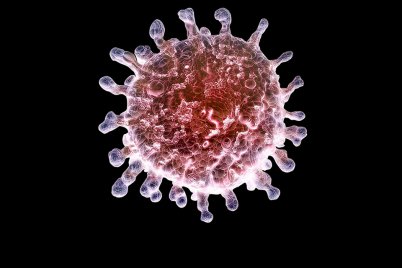
A field worker from MRC Unit The Gambia at LSHTM uses a thermal imaging camera to measure a mother and her unborn baby's temperature in Keneba as part of a study looking at the impact of heat stress on pregnant farmers. Credit: Louis Leeson/LSHTM
This feature is available for republication under a Creative Commons licence.
LSHTM scientists are researching solutions for a healthy future in the face of a changing climate.
For years, researchers have been warning that as well as a threat to the environment, climate change is also a very real threat to human health. Soaring temperatures, rising sea levels and an increase in the number and intensity of extreme weather events such as storms and floods will have a huge impact on the health of everyone around the world.
Some of the poorest parts of the planet and those who have done least to contribute to the climate crisis have been feeling the force of this for some years now. But the richest are also starting to wake up, says Sir Andy Haines, professor in environmental change and public health at the London School of Hygiene and Tropical Medicine (LSHTM).
He points to the devastating wildfires in California this summer as a sign of how climate change is no longer a “distant threat” to people in richer countries and one which he hopes will galvanise more people into action.
“Climate change has always been framed as an environmental issue and it’s always difficult to get traction on that but researchers have been conceptualising it as a health issue and we hope people will start to take notice,” he says.
UK researchers are leading the world in coming up with both mitigation strategies - limiting warming - and adaptation, working out how to live with changing weather patterns. By doing both there will be huge benefits to health.
“We need to mitigate - so we need to cut emissions. But we also need to adapt to create more resilient societies,” says Prof Haines.
But what can we do to push forward on it? Here are 10 ways that climate change will affect health, and how LSHTM researchers are tackling these monumental challenges.
1. Too hot to handle
Extreme heat is perhaps the most obvious sign of a warming planet - but as well as the environmental effects of droughts and parched land, high temperatures can be extremely harmful to human health.
Quantifying this invisible killer is paramount. Research carried out by Antonio Gasparrini, professor of biostatistics and epidemiology at LSHTM, showed that by the end of this century all regions of the world will see deaths associated with extreme heat, with the poorest regions affected more than others.
The research showed that for every projected 1°C increase in temperature there will be an additional 0.05 per cent risk of mortality. And by 2099, excess deaths related to extreme heat will increase in all countries or regions by 1.4 to 10.3%.
Temperature increases are likely to be greatest in sub Saharan Africa where people will also find it harder to mitigate the effects of extreme heat against existing or growing health challenges. An 11-year study in Burkina Faso found that exposure to moderate or extreme heat significantly increased premature mortality from non communicable diseases. Even the UK will be affected. Research carried out by LSHTM and Public Health England estimated that by 2050 the number of deaths associated with heat will rise by about 250 per cent.
Extreme heat is particularly harmful to older people who are more likely to have other conditions, such as cardiovascular or respiratory disease, that make them vulnerable. Pregnant women are also at risk – a recent analysis by LSHTM and other researchers compared daily temperatures to birth rates in the United States and found there were more births on days of extreme heat and the following day. The researchers estimated that an average of 25,000 infants per year were born earlier as a result of increased exposure to hot weather.
But while limiting temperature rise itself is of course important there are steps we can take to lower temperatures, particularly in cities which generate a ‘heat island effect’. From planting more trees to painting roofs and covering roads in heat-reflecting rather than absorbing materials, experts are coming up with innovative ways to turn down the heat. The UK Climacare study, led by a coalition of UK researchers, is looking into how extreme heat affects care facilities and finding ways to mitigate it.
2. Fires, floods, and storms
Thousands of people are killed and injured every year in disasters such as floods, storms and wildfires linked to climate change - with the effects being both short and long term. These events are devastating both in human and economic terms - in 2018, 831 extreme weather events resulted in US$166 billion in economic losses. Some 30 people were killed during the bushfires that swept through Australia in the 2019 to 2020 summer. And a further 445 deaths were linked to smoke inhalation and more than 4,000 people were admitted to hospital.
In Pakistan in 2010 more than 15 million people were affected by flooding, with around six million people needing medical care. And heavy rains have other, longer-term consequences: standing water caused by heavy rainfall or overflow of rivers act as breeding sites for mosquitoes, which carry diseases such dengue, malaria and West Nile fever.
In 2019 Cyclone Idai hit Mozambique just as people were about to harvest their crops, meaning they were left without food and many lost their livelihoods. The land was contaminated by seawater for months, making it harder for many to rebuild their lives.
Building resilience among communities that are vulnerable to climate change is vital.
3. Enough healthy food for all
Climate change and changing weather patterns are affecting the food we grow by reducing both crop yields and quality. A study by researchers at the University of Minnesota found that climate change is reducing global rice yields by 0.3% and wheat yields by 0.9% on average each year, with people in the developing world most vulnerable.
But richer nations are becoming increasingly reliant on exotic fruit and vegetables from climate vulnerable countries. Astudy led by Dr Pauline Scheelbeek from LSHTM found that domestic production of fruit and vegetables in the UK dropped from 42% in 1987 to 22% in 2013. At the same time the proportion imported from climate-vulnerable countries increased from 20% to 32%. People in the UK may have to revert to more sustainable food sources – like ditching bananas that have been flown halfway round the world to home-grown apples in autumn.
But while eating more sustainably is important researchers are working on developing supercrops that are both resistant to extreme weather and have been fortified with minerals and vitamins. For example, the UK government has funded development into ‘scuba rice’ which can survive being completely submerged in water, so heavy rains and flooding wouldn’t affect output
Food production is also linked to climate change - the global food system is thought to produce about 20 to 30 per cent of all carbon emissions. The Sustainable and Healthy Food Systems research team (SHEFS) at the LSHTM is carrying out essential research to help governments design systems that deliver healthy, nutritious food but in a sustainable and equitable way.
4. Spreading disease
While the number of deaths from malaria has fallen sharply over the last decade, this mosquito-transmitted disease still kills nearly half a million people every year, the majority of whom are children under five in sub Saharan Africa.
Recent research from the World Health Organization shows that changing weather patterns linked to climate change mean there will be at least 60,000 more deaths from malaria between 2030 and 2050 as hotter climates are more favourable environments for mosquitoes. Mosquito-transmitted viruses such as dengue, chikungunya and Zika, are also becoming more common. Dengue virus - which causes excruciating muscle and joint pain - has exploded across the world in recent years. In 1970, just nine countries around the world saw outbreaks of the disease compared to more than 100 today, including southern Europe.
Many of the control efforts used to battle the malaria mosquito such as insecticides, treated bed nets and preventive treatments have been pioneered by UK researchers, particularly at the LSHTM. But as dengue becomes increasingly prevalent and a burden on societies more sophisticated techniques are being developed. LSHTM researchers such as Dr Rachel Lowe are working on an early warning system that uses seasonal climate forecasts to predict dengue outbreaks up to seven months in advance.
5. A lot on our minds
There is growing evidence of the link between mental health and climate change - countries hit by climate-related disasters such as floods or droughts linked to changing weather patterns are likely to see an increase in the number of people suffering mental health conditions such as depression and anxiety.
Researchers are still trying to understand the link between high temperatures and mental health. Work by Antonio Gasparrini shows there may be a temperature range where suicide is more common. Researchers such as Elaine Flores, who recently completed her PhD at LSHTM looking at the mental health outcomes relating and resilience strategies associated with El Niño Southern Oscillation (ENSO) in Peru, are becoming increasingly interested in promoting resilience in communities that are particularly vulnerable to climate change.
Dr Sari Kovats at LSHTM led a study of people whose homes had been flooded in England and found that those who did not have insurance were more likely to report depression or anxiety.
There is also growing recognition of ‘eco-anxiety’, with younger people thought to be particularly at risk. People describe despair, and guilt associated with the climate crisis and other global environmental issues and a feeling of helplessness. Researchers in the UK are looking into whether climate activism can mitigate eco-anxiety.
6. Water for life
From rising sea levels and temperatures to an increase in frequency of droughts and floods, the water we drink and use to grow our food is likely to be affected both in terms of both quantity and quality. Warmer water temperatures can encourage the growth of harmful algal blooms that poison marine and aquatic life, risking an increase in gastro-intestinal diseases as well as a loss to the livelihoods of those who rely on fishing as a source of income.
Rivers that have burst their banks and overflowing sewage systems can lead to outbreaks of waterborne diseases such as cholera, typhoid and dysentery - a particular risk for those who are displaced, living in crowded conditions or are one of the one in three people globally who do not have access to clean water and sanitation.
The Bill and Melinda Gates Foundation have long been interested in developing an alternative to the standard plumbed-in sanitation system and have challenged designers to come up with innovative solutions. Alternatives have included a toilet that runs on solar energy and another that recycles waste into electricity.
7. Lives and livelihoods
In 2018, 133.6 billion hours of labour were lost because of heat alone, 45 billion more than in 2000.Research led by Professor Andy Haines from LSHTM shows that for many people living in the hottest parts of the world - central and west Africa and south and south east Asia - working will be near on impossible during the hottest months of the year. An average temperature increase of around 2.5°C will affect up to one billion people, the research shows, with people living on the lowest incomes the worst affected.
People in the poorest countries will be unlikely to work in an environment where they will be able escape the heat or where there will be any cooling - for example if they work as farmers or labourers - so they will either have to stop working during the hottest months or risk the consequences of extreme heat.
8. Forced migration
An increase in poverty and a fight for scarce resources is likely to see an increase in migration. However, most of this movement is likely to be within countries - a move from the country to the city, for example. In Bangladesh, for example, millions of people have moved to the cities in recent years because of an increase in floods.
There are many ways that changes in climate can force people to leave their homes. An extreme weather event such as a storm or flood may wipe out a family’s home and crops, forcing them to start their life elsewhere. A decrease in rainfall over many years may make the land increasingly infertile. And a reduction in crop yield may make farming no longer tenable. Increasing people’s resilience to climate-related shocks is paramount - planting drought or flood-proof crops or ensuring people have adequate insurance.
9. Countries in conflict
According to the International Committee of the Red Cross, 20 of the countries which are most vulnerable to climate change are also mired in conflict - Yemen, Mali, Afghanistan, and the Democratic Republic of Congo.
The conflicts are not necessarily linked to changing weather patterns but these countries are among the most vulnerable to the climate crisis and have been the most neglected by any kind of action to mitigate or adapt to changing weather patterns. The ICRC highlights an example from Mali, where social unrest coupled with a lack of grazing land due to floods has led to problems for farmers. Nomadic farmers were worried about travelling with their livestock as they were worried about being attacked by armed groups. So they gathered in areas close to water sources, creating tensions with settled farmers and fishermen.
The ICRC warns that by 2050, 200 million people living in these countries may need humanitarian aid - double the number now.
10. The air we breathe
According to the WHO, air pollution is linked to about 4.2 million deaths a year due to stroke, heart disease, lung cancer and chronic respiratory diseases. A recent estimate suggests that about 3.6 million premature deaths annually can be attributed to outdoor air pollution from burning fossil fuels. Fine particles can get deep into the lungs leading to inflammation, carbon monoxide can reduce the oxygen in the blood and gases such as nitrogen can irritate the respiratory system. LSHTM’s Prof Paul Wilkinson has undertaken research showing that the closer homes are to greenspaces, the less air pollution is found indoors.
Tackling indoor and outdoor pollution from transport, heat and power generation and outdated cooking sources such as wood-burning stoves - and transitioning to renewables - is an example of a double duty effect. If this objective is achieved by decarbonising the economy, not only will this lead to a reduction in the greenhouse gas emissions and tackle climate change this will also clean up the air we breathe.
Research by Prof Haines highlighted some triple duty effects - cutting air pollution will improve health as well as cutting down on emissions but will also bring other positives.
An increase in walking and cycling will benefit physical and mental health. And a reduction in the consumption of meat in high income countries will free up land and improve physical health, particularly if accompanied by increases in consumption of fruit, vegetable and nut and seeds.
“Systemic change is what is needed,” says Prof Haines, pointing out that tackling problems individually can lead to unintended consequences. For example, insulating houses to make them more energy efficient can also lead to an increase in indoor air pollution.
Prof Haines is neither optimistic nor pessimistic about the task ahead – researchers around the world are working hard to provide evidence of the scale of the threat. Climate change is potentially catastrophic for human health. We must adapt to change where we can, and prevent changes that we can’t adapt to. Then we can reap the health benefits of a zero carbon economy as well as reduce the risks from dangerous climate change.
As Prof Haines urgently notes, “We must keep pushing forward as fast as we can against the very big barriers that are in front of us.”
This article is part of the Decade of Health campaign from organisations across the UK – including LSHTM – who are working to make the world healthier and safer through innovation and collaboration. Check out decadeofhealth.co.uk and find out more about how research institutes are bringing together the world’s greatest scientific minds to develop solutions to health challenges such as climate change, antimicrobial resistance and COVID-19.
Listen to more LSHTM Viral podcasts.
COVID-19 Response Fund
There cannot be any complacency as to the need for global action.
With your help, we can plug critical gaps in the understanding of COVID-19. This will support global response efforts and help to save lives around the world.
Support LSHTM's COVID-19 Response Fund





